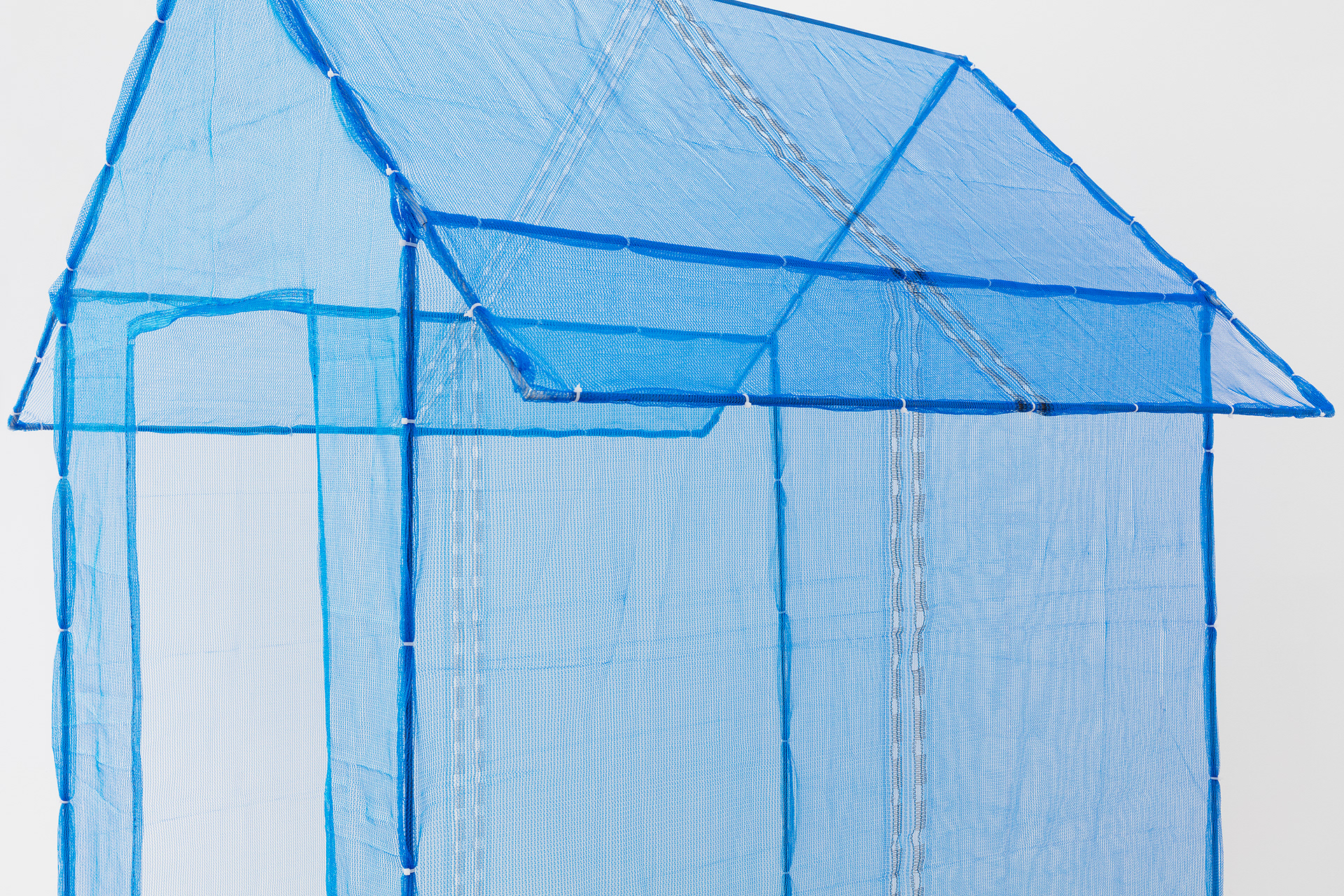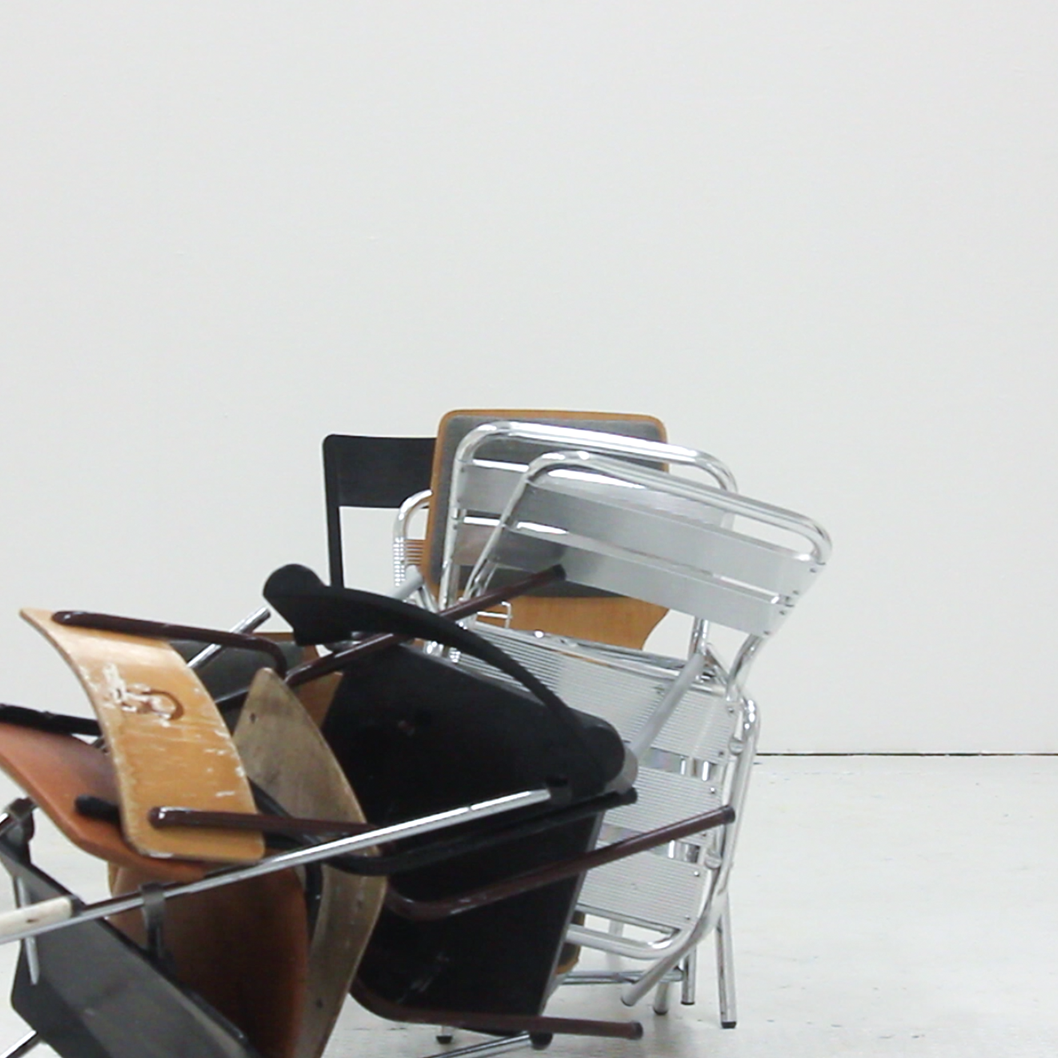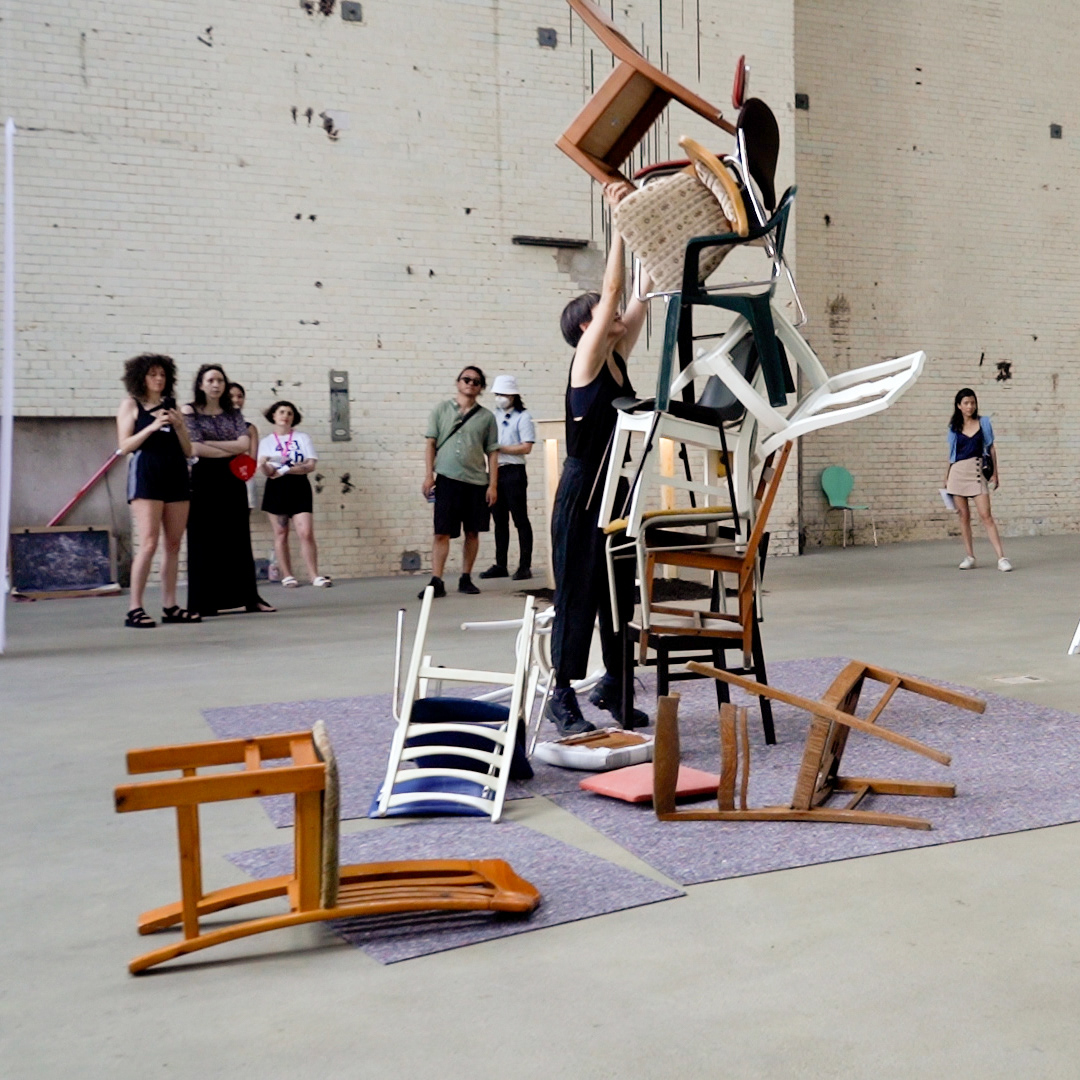Installation view at Projektraum 145, photo: CHROMA- André Carvalho
Haus der Fremde
2015/2022
Edelstahl, Baugerüstnetz, Räder, Kabelbinder
BTH 100 x 210 x 150 cm
Haus der Fremde reflektiert, wie sich Vorstellungen von „Zuhause“ – insbesondere im Kontext transnationaler Identitäten – konstruieren, verschieben und destabilisieren. Das Werk nutzt Baumaterialien wie Gerüstrohre und Netze, um eine häusliche Struktur zu bilden, die auf die Fragilität von Zugehörigkeit verweist, wenn „Heimat“ kein fixer Ort ist, sondern sich ständig verändert.
Begriffe wie Heimat, zu Hause sein und 집 verweisen auf kulturell aufgeladene Konzepte von Identität und Verortung. Die modulare und mobile Konstruktion lädt Besucher:innen dazu ein, sich physisch mit dem Objekt zu bewegen – ein performativer Akt, der die andauernde Aushandlung von Ort, Sicherheit und Sichtbarkeit im Leben migrantischer Körper spiegelt. Dieses Haus bleibt nicht an Ort und Stelle – es verschiebt sich mit der Zeit. So wie auch die Körper, die es metaphorisch beherbergt.
Haus of Alien
2015/2022
stainless steel, scaffolding net, wheels, cable tie
100 x 210 x 150 cm
House of the Alien reflects on how ideas of “home” are constructed, displaced, and destabilized—especially within the context of transnational identity. The work uses scaffolding materials from construction sites to form a house-like structure, referencing the fragility of belonging for those whose “home” is never fixed but always in flux.
Drawing on the loaded terms Heimat, zu Hause sein, and 집, the work asks how personal and cultural identity is spatially imagined. The modular, mobile frame invites visitors to physically move the structure, echoing the constant negotiation of place, safety, and visibility in migrant experience. The house shifts over time—it cannot stay in one place, just like the bodies it metaphorically holds.
이방인의 집
2015/2022
100 x 210 x 150 cm
스텐리스 스틸, 건축용 분진망, 케이블 타이, 바퀴
<이방인의 집>은 ‘집’이라는 개념이 어떻게 구성되고, 이동하며, 불안정해지는지를 성찰한다. 특히 국경을 넘나드는 정체성의 맥락에서, 이 작업은 고정된 장소에 소속되지 못하는 존재들이 감내하는 ‘소속감의 불안정성’을 이야기한다.
건축현장의 비계 자재를 사용해 만든 이 집의 구조는 독일어 Heimat, zu Hause sein, 한국어 집과 같은 장소 특정적 정체성 개념을 소환한다. 모듈화된 이 구조물은 언제든 이동이 가능하며, 관람객은 직접 구조물을 밀고 움직이며 경험할 수 있다. 이 물리적 상호작용은 ‘머무름’과 ‘보호’, ‘가시성’ 사이에서 끊임없이 조정되는 이주자의 현실을 반영한다. 이 집은 시간이 지나며 원래 위치에 머물지 않고 서서히 이동하게 된다. 그것이 상징하는 몸처럼, 이 집은 한 곳에 머물 수 없다.



Photo: Chromaistanbul
„Jinran Ha Haus der Fremde (2022, erste Version 2015) befragt als zweite Haut für einen menschlichen Körper das Verhältnis zwischen dem ganz privaten Raum und den sozialen Kontexten, in denen wir uns bewegen.
In ihren Dimensionen erinnert die mobile Skulptur an einen minimalen Schutzraum. Das halbtransparente Material, das eigentlich Baugerüsten zur Abschirmung dient, bietet jedoch verschwommene Ein- und Ausblicke und bildet keinerlei verlässliche Abschirmung gegen Wettereinflüsse. Auch die Struktur mit den feinen Stäben und den winzigen Rollen wirkt
In ihren Dimensionen erinnert die mobile Skulptur an einen minimalen Schutzraum. Das halbtransparente Material, das eigentlich Baugerüsten zur Abschirmung dient, bietet jedoch verschwommene Ein- und Ausblicke und bildet keinerlei verlässliche Abschirmung gegen Wettereinflüsse. Auch die Struktur mit den feinen Stäben und den winzigen Rollen wirkt
so fragil, dass sie von jedem Windhauch in Bewegung gesetzt und auch zu Fall gebracht werden könnte. Das Blau des zarten Gewebes lässt an Himmel oder Wasser denken. Als Farbe des Traums und der Melancholie gibt es dem kleinen Gebäude eine sehnsuchtsvolle, poetische Dimension."
Text: Stefanie Bringezu
„... ihrer Arbeit Haus der Fremde (2015) liegt etwas Groteskes zugrunde. Sie besteht aus einem mobilen Heim, für das Ha nur minimale Mittel einsetzt. Über dünne Metallstäbe spannt sich ein transparenter blauer Stoff, der Wände, Eingang und Satteldach einer archetypischen Behausung beschreibt. Praktischerweise hat Ha darunter Rollen montiert, sodass dieses Haus in der Fremde theoretisch überall Schutz bieten könnte – wären die Rollen nicht viel zu klein, das Haus recht fragil und der Stoff ohnehin sehr dünn. Es wird deutlich, dass der poetische Titel zwischen Versprechen, Behauptung und Unmöglichkeit schwankt. Denn um dieses instabile Haus zu bewegen wird den Benutzern schon einiges an Beharrlichkeit abverlangt, eben jene Beharrlichkeit, die Has Arbeiten stets zueigen ist."
Text: Akiko Bernhöft
“... There is something grotesque about her work Haus der Fremde (2015). It consists of a mobile home for which Ha uses only minimal means. A transparent blue fabric is stretched over thin metal rods, describing the walls, entrance and pitched roof of an archetypal dwelling. Conveniently, Ha has mounted castors underneath so that this house could theoretically offer protection anywhere - if the castors weren’t far too small, the house quite fragile and the fabric very thin anyway. It becomes clear that the poetic title oscillates between promise, assertion and impossibility. Because in order to move this unstable house, a certain amount of perseverance is demanded of the users, precisely the perseverance that is always characteristic of Has’s work.”
Text: Akiko Bernhöft
"As a second skin for a human body, Jinran Ha Haus der Fremde (2022, first version 2015) questions the relationship between the very private space and the social contexts in which we move.
The dimensions of the mobile sculpture are reminiscent of a minimal shelter. However, the semi-transparent material, which is actually used to shield scaffolding, offers blurred views in and out and provides no reliable shielding against the weather. The structure with its fine rods and tiny rollers also appears so fragile
The structure with its fine rods and tiny rollers also appears so fragile that it could be set in motion and brought down by any breeze. The blue colour of the delicate fabric is reminiscent of the sky or water. As the colour of dreams and melancholy, it gives the small building a longing, poetic dimension."
The structure with its fine rods and tiny rollers also appears so fragile that it could be set in motion and brought down by any breeze. The blue colour of the delicate fabric is reminiscent of the sky or water. As the colour of dreams and melancholy, it gives the small building a longing, poetic dimension."
Text: Stefanie Bringezu











